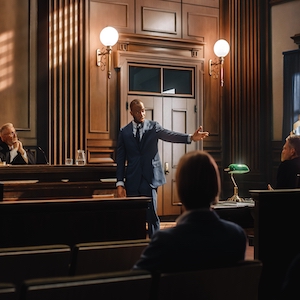By Dr. Ken Broda-Bahm:

There are many phases to a trial. Some of those phases are just for lawyers, but some of them really should include the clients as well. The voir dire process, where the ultimate jury is selected, is one of those latter phases. The clients for all parties should be there. But I’ve noticed a disturbing trend in my own cases — in the last three picks, in three different states, the Plaintiffs themselves attended none of the jury selections. In those cases, I was working for the Defense, and we had a client representative present and participating in all of them. But on the other side of the room, there was just counsel.
Now I suspect that opposing counsel was thinking, “This can be a drawn out process, we don’t know how long this will last, and we almost certainly won’t open today… so let’s go ahead and tell the clients they can come tomorrow.” But the kind of thinking treats jury selection as a pre-trial formality, or a game for lawyers. But it isn’t, or shouldn’t be. Voir dire is trial, and it is the critical first part of trial. My recommendation in this post is that when you have your conversation with any client about whether they need to be there on those early jury selection days, the answer is that “Yes, you do… and there are five good reasons for that.”
Yeah, I know it’s another day in court
but you should attend jury selection…
…because first impressions matter
If you watch that pool of potential jurors filing into a courtroom and waiting, you’ll notice that they’re paying attention to everything — the wood paneling, the flags, the raised dais and bar, and all the other symbols of authority, but also all of the people. They study all the suited participants, and, I think, form theories about who everyone is. In that context, being there creates an opportunity to convey a good first impression, and once we get under way, to be introduced to that pool of potential jurors.
…because case ownership matters
An absent client sends the message from the start that this process is about the attorneys and not about the clients. If jurors are just seeing a room full of lawyers, it appears as though it is their case, and not a case that belongs in the end to the clients. That can be a very bad message for all sides, but particularly for those who are seeking compensation. Being present at jury selection conveys to the message to the panel that, “I am here to seek justice and I’m looking for your help in getting it.”
…because better answers matter
When the clients are present, I think that has an effect on the overall context and how the answers are framed. In other words, we aren’t talking about your attitudes toward serious injuries and lawsuits in general, we are talking about your attitudes toward her injury, and this lawsuit. While it is conceivable that potential jurors might be inhibited from revealing true feelings, if someone isn’t already inhibited by atmosphere, the judge, and the counsel, it is unlikely they would be further inhibited by the presence of the client. Ultimately, we want to know how they’ll react to the story of the case when it is presented in the client’s presence, so voir dire is a good time to start that. It gives a focus and a context to what would otherwise be an abstract discussion of experiences and attitudes.
…because equal treatment matters
This is an easy one: The jurors and the potential jurors are thinking, “We have to be here the entire time, we can’t even use the restroom without permission until we’re dismissed by the judge. So why is he able to come and go as he pleases?” That perception of being more privileged than the jurors, and being willing to use that privilege isn’t going to help you win the jury over.
…because avoiding a surprise matters
During one previous jury selection, the Plaintiff — a young woman claiming a brain injury — entered late in the process, and her attorneys decided to quickly introduce her to the panel. Granted, she hadn’t testified, and the members of the panel really had not heard anything yet on the nature of her injuries, but they still shared some important reactions: “She isn’t as injured as I expected her to be,” and “She looks like she is doing pretty good.” Naturally, it is better to learn that during selection, when it can factor into a strike decision, than to learn that only later as part of a post-verdict conversation.
Ultimately, jury selection is trial. It is the critical first part of trial, so the parties should be there.
____________________
Other Posts on Jury Selection:
- Keep Your Mini-Opening to its proper purpose
- Catch Up in Voir Dire: Ten Questions to Ask when a New Face Suddenly Joins Your Panel
- Save the Strikes: ASTC’s Research-Based Case Against Prohibiting the Peremptories
____________________